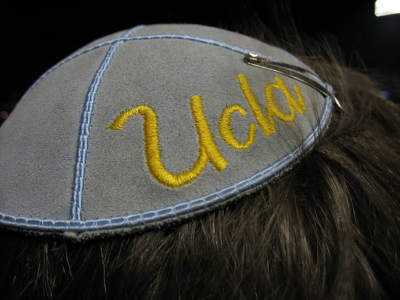Originally published in Ha’am.
In our era, different societies and communities worldwide advocate pluralism heavily. Pluralism is a uniquely modern idea, in which a society allows – or even encourages – the coexistence of more than one system of thought and values. Unsurprisingly, pluralistic ideals have been heavily championed in our own UCLA Jewish community by different student-led groups and the Hillel itself. While the focus on creating a pluralistic environment where all are welcome is a step in the right direction, I fear that the inherent ideals of pluralism are sometimes lost on the community at large, which inevitably leads to conflict. Rather than view each conflict that may arise in our Jewish community as a unique difficulty, I think that we need to re-examine the philosophical underpinnings of pluralism in hopes of creating a stronger, more unified UCLA Jewish community.

There are many different types of conflicts that can and will inevitably arise amidst a Jewish pluralistic community. These conflicts can range from simple and pragmatic questions to questions of identity, end-goals and theology. Two simple examples will suffice to show the breadth of conflicts that may arise in the attempt to create a pluralistic space.
Orthodox custom demands that a male lead all services, including Kiddush – the blessing over wine – on Friday night, while Conservative and Reform communities hold egalitarianism at the forefront of their value systems. If we acquiesce to the Orthodox custom by only allowing males to make Kiddush, then we will be explicitly denying egalitarian ideals. Imagine a Reform or Conservative female who is unable to lead Kiddush for her entire college career because it will make the Orthodox group feel uncomfortable. Her inability to lead the prayers will, rightfully so, lead her to the conclusion that Orthodox demands and values are being placed higher than her own.
However, if we imagine the case in reverse, the same argument can be made. Let us imagine that this same female occasionally leads Kiddush, thus causing the Orthodox community discomfort. They will feel that their customs and values are given less weight than those of their peers.
While the previous case is more pragmatic (although it does touch on deeper issues), we can imagine a much more complex case with greater repercussions than can possibly arise in the Kiddush example. Different sects of Judaism have very different conceptions of who is a Jew. Let us imagine for the moment that our community unanimously agrees that the person who leads Kiddush must be Jewish. The obvious question then becomes: according to who? Orthodoxy does not view non-Orthodox conversion as legitimate and some forms of Conservative Judaism do not view Reform conversion as legitimate. To make matters more complicated, Reform (and some Conservative) communities view Jewish identity as stemming from either patrilineal or matrilineal descent while other groups of Conservative Jews, along with the entirety of the Orthodox community, only attach Jewish identity to matrilineal descent.
These conflicts lead to much more consequential and far reaching conclusions than simply who feels comfortable during Kiddush. Setting aside all pragmatic matters, individuals’ Jewish identity is now called into question. Even in the most sensitive conversations, people’s feelings will be hurt and their feeling of belonging may be questioned.
Rather than proposing potential solutions and wading into the technicalities of certain situations, I want to suggest a way to reframe our viewpoint (regardless of our opinions) on these matters. The concept that a community can not only survive but flourish while allowing a multiplicity of viewpoints and free discourse to exist was unheard of for the vast majority of human history. While there have always been different views and voices within the Jewish community, it would be difficult to argue that there was any sense of pluralism present in our history.

Any idea of freedom of speech or the desire to cater to multiple viewpoints is virtually absent from the biblical record (this should not be viewed as an attack but rather a realization that societies were vastly different in biblical times). The Second Temple sectarian groups frequently polemicized against one another, blaming each other for the calamities befalling the Jewish community. In the Talmudic and subsequent medieval periods, heretics were excommunicated, theological disagreements often ended in book burnings and communal arguments generally consisted of ad-hominem attacks or other threats. Even in the last hundred years, great thinkers, such as Mordecai Kaplan, were excommunicated by a large portion of the Jewish community. While the Midrash (Numbers Rabbah) does teach that there are 70 faces to the Torah, for most of Jewish history, it seems as though each individual community felt that it was the sole possessor of all 70.
We are at a unique point in Jewish history. Our community at UCLA is made up of Jews with all types of backgrounds and opinions. Rather than engaging in the hatred and disunity that was prevalent for much of Jewish history, our diversity of opinion is something that we celebrate. In a true Maimonidean sense of teshuvah (repentance) we have the opportunity to come together and fix the mistakes of the past generations, proving that pluralism is truly a Jewish ideal.
If we as a Jewish community really believe in pluralism, we must first understand and internalize a couple of fundamental ideas. As alluded to earlier, the basis for an idea such as idealistic pluralism can only truly arise from a post-enlightenment, democratic society, where each individual is freely granted the ability to express his or her ideas and opinions. Add this idea to our modern reality, where opinions are no longer decided solely based on authority or tradition but are based in reason and rationality, and we can begin to understand the underpinnings of pluralism. Once we recognize that we live in a society where ideas can freely flow and are judged based on merit, we can recognize the differences of opinion on a gamut of issues that emerge.
This idea is nicely summed up by the social and political philosopher Charles Taylor who states: “We live in a condition where we cannot help but be aware that there are a number of different construals, views which intelligent, reasonably undeluded people, of good will, can and do disagree on.” Taylor’s main point is that in our society, we need to recognize that not only is there a difference of opinion but also that people who hold different opinions are not less intelligent, immoral or even wrong.
Once we, as a community, are able to reach a certain level of maturity and realize that the multiplicity of opinions in our community is a positive aspect, we can then transition to discussing an important – but often overlooked – factor of pluralism. In a pluralistic community, each individual or micro-community contributes ideas and values to the wider community. Those values that have been formed by a smaller community and adopted by the larger community are the ideals that, as a whole, make up the ideology of the community. We are then, as a community, presented with a sum of different and potentially contradictory opinions. But in a very Gestaltian sense, our community is much greater than the sum of its parts.
However, here comes the difficult part – one that will only work if we truly believe in pluralism as an ideal way to run a society rather than just a cute buzzword to showcase our open-mindedness. When any question arises in a pluralistic community, we are not looking for what we may think to be the objectively correct answer but rather what I will term “the pluralistic average.” In order to truly uncover a community’s pluralistic average, we need to counterintuitively understand that we are no longer looking to discover the truth. The end-goal of pluralism is not to engage in an exchange of ideas in search of some objective truth; rather, the goal is to create a community that caters to all of its members. Of course, debate and discussion can and should be continued amongst the members of our Jewish community. Friendly debate is, after all, one of the greatest parts of Judaism. However, for the purpose of truly living up to pluralistic ideals, we need to understand that proving our point is not the end goal. We must accept that people can and will disagree with us because the truth is, in most cases, elusive and unreachable.
I do not want to be misunderstood as arguing that creating a pluralistic community involves a lack of truth. It is just the contrary. As stated earlier, in today’s postmodern world, people are beginning to realize that it is very difficult to deem one opinion “more correct” than others. Of course, we, as a community, are going to set up certain foundational boundaries of what we consider to be an acceptable position (perhaps a future article will discuss this important idea). However, it is difficult to defend any position based on pure reason or logic.
Let us use our Kiddush example as a case study: it is reasonable to posit that a Reform Jew values the idea of egalitarianism above tradition and vice versa for an Orthodox Jew. Both of these parties can create valid arguments as to why their method is more ideal for a communal Kiddush. However, it would be silly to suggest that either of these positions is more logical. Each of these groups are just starting out with different, “unprovable” premises or assumptions regarding which ideas (in this case, egalitarianism/tradition) are more important, and their view on who should make Kiddush directly follows.
In order to create a real pluralistic community, we need to come together and realize that it is futile to continue to argue that one of these points is more “correct” than the other and instead strive for the more important goal of communal unity. While this means that both groups will have to give up their a priori assumptions that they are correct, it is the only way to create a real pluralistic community. The creation of a true pluralistic community needs its members to be like Aaron the Priest, who always sought out compromise (Sanhedrin 6a). In some cases, this requirement may mean that one group has to occasionally give up their conception of what is absolutely true in order to be more inclusive. In other cases, it may mean that another group needs to occasionally give up their idealism for a pragmatic solution that can make others comfortable. At this point, I do not want to give any practical examples of what to do in these very real and difficult situations that inevitably arise in our Jewish community. All I hope to do at this time is reframe our idea of what we are striving for when we set out to create a pluralistic community. Only by paradoxically leaving behind our natural desire to prove that all of our opinions are true can we create a genuinely pluralistic, unified Jewish community.
Daniel Levine is currently a graduate student studying religion at UCLA. Last spring he graduated UCLA with a dual degree in Cognitive Science and Jewish History. Alongside his undergraduate studies, he also studied for, and will soon receive, Rabbinical Ordination from YPS. His interests include religious history, philosophy, psychology, and sociology. For more articles by Daniel, visit his blog at whoknowsoneblog.wordpress.com.
![UCLA yarmmulke "Pluralistic ideals have been heavily championed in our own UCLA Jewish community..." | By Eric Chan [CC BY 2.0], via Creative Commons](https://newvoices.org/wp-content/uploads/2017/01/UCLA-yarmmulke.jpg)
